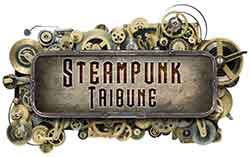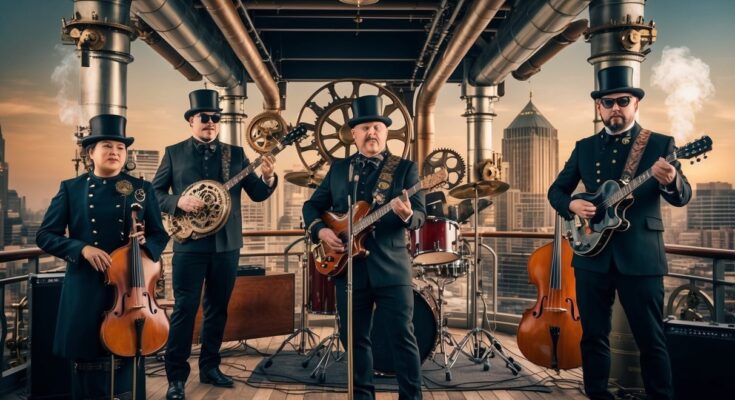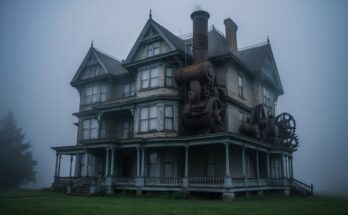Steampunk music embodies a unique fusion of vintage aesthetics and modern sounds, drawing inspiration from the Victorian era’s imagination. This genre often features instruments like mechanical keyboards, brass ensembles, and eclectic soundscapes, creating an atmosphere that resonates with the fantastical elements of steampunk culture. Steampunk music serves as a vibrant backdrop for conventions, events, and gatherings, immersing listeners in an alternate reality where technology meets artistry.

Many artists within this genre blend various styles, including folk, classical, and electronic, to craft a distinctive auditory experience. This rich musical tapestry not only invites exploration but also expands the boundaries of creativity, appealing to those who appreciate both history and innovation. Through its compelling melodies and engaging performances, steampunk music transports audiences to a world filled with wonder.
For enthusiasts and newcomers alike, the appeal lies in its ability to evoke nostalgia while embracing the new. As they dive deeper into this genre, listeners often discover communities, events, and collaborations that further enhance their appreciation of steampunk culture. Engaging with steampunk music can lead to a more profound connection to the genre, amplifying its allure and significance.
The Roots of Steampunk Music

Steampunk music draws on a rich tapestry of historical and cultural influences, primarily from the Victorian era and punk genres. This fusion creates a unique auditory experience that reflects the aesthetics and ideologies of both time periods.
Historical Development
Steampunk music began to emerge in the late 20th century as part of the broader steampunk movement, which encompasses literature, fashion, and art rooted in the Victorian era. Artists started to reinterpret traditional genres through a steampunk lens, incorporating anachronistic instruments and themes. The genre evolved alongside the popularization of steampunk culture in literature and film, with notable works like The Difference Engine by Gibson and Sterling igniting interest.
Influences from the Victorian Era
The Victorian era, characterized by rapid industrialization and a fascination with science, heavily influences steampunk music. Instruments such as the hurdy-gurdy and various brass instruments evoke the sounds of this time. Lyrics often reflect themes of adventure, invention, and social commentary, mirroring Victorian literature. The aesthetic choices in steampunk music echo the visual styles of the era, emphasizing craftsmanship and intricate design, creating a nostalgic yet innovative soundscape.
Relationship With the Punk Genre
Steampunk music maintains strong ties to the punk genre, both ideologically and stylistically. Punk’s DIY ethos resonates within the steampunk community, encouraging artists to create and perform independently. Additionally, the rebellious spirit of punk informs the lyrics and performances in steampunk music, often addressing themes of individuality and societal norms. Fusion bands that blend punk rock with steampunk instrumentation showcase the adaptability of both genres, appealing to a diverse range of listeners.
Characteristics of Steampunk Music

Steampunk music combines various musical elements with distinctive aesthetics, lyrical storytelling, and a unique visual presentation. This genre reflects the imaginative roots of the steampunk movement, capturing an era that intertwines technology and Victorian influences.
Musical Elements and Aesthetics
Steampunk music often features a blending of genres, including folk, industrial, and classical styles. Instruments like the accordion, violin, and various percussion tools are commonly used, creating a rich soundscape.
Rhythm and Melody
The rhythms are often syncopated and upbeat, invoking a sense of motion reminiscent of steam-powered machinery. Melodies tend to be whimsical and sometimes melancholic, aligning with the storytelling aspect.
Production Techniques
Production choices frequently incorporate vintage sounds, such as phonograph recordings or analog instruments, which emphasize the historical aesthetic. This sonic palette fosters an immersive experience, aligning with the visuals found in steampunk art.
Lyrical Themes and Storytelling
Lyrical content in steampunk music frequently explores themes of adventure, exploration, and technology. Songs often tell stories of airships, inventors, and romantic escapades, weaving narratives that capture the imagination.
Character Development
Characters in these songs range from daring protagonists to enigmatic inventors, often facing challenges that reflect human ambition and curiosity. This use of character adds depth and engagement for listeners.
Imagery and Symbolism
The lyrics commonly employ rich imagery and symbolism, drawing on Victorian literature and aesthetics. Metaphorical references to clockwork, steam engines, and fantastical machines enhance the storytelling experience, allowing listeners to visualize the world being described.
Visual Presentation and Design
The visual aspect of steampunk music goes beyond just the audio; it includes album artwork, performances, and fashion. A distinctive style characterized by Victorian costumes, goggles, and mechanical accessories accompanies performances.
Album Artwork
Art on album covers often features intricate designs, showcasing gears, cogs, and other mechanical elements. This gives audiences a preview of the fantastical and vintage world they can expect from the music.
Live Performances
Live shows may include elaborate stage setups that reflect a steampunk aesthetic, enhancing the overall experience. Musicians often dress in period-inspired attire, creating a cohesive visual identity that complements the sound.
Through music, lyrics, and design, steampunk embodies a unique fusion of past and future, offering an engaging cultural experience.
Steampunk Music and Technology
Steampunk music intricately weaves together historical influences with modern technologies. This fusion creates unique instruments and innovative soundscapes, enhancing both the listening experience and live performances.
Instruments and Soundscapes
Steampunk music often features a blend of traditional and unconventional instruments. The use of acoustic guitars, violins, and percussion is common, but many musicians incorporate circuit-bent devices, synthesizers, and steam-powered instruments to create distinct, organic sounds.
The soundscapes produced are characterized by rich textures influenced by Victorian aesthetics. Musicians utilize mechanical sounds and ambient effects to evoke a sense of nostalgia, maintaining a consistent steampunk theme. This results in compositions that transport listeners to an alternate reality marked by steam and brass machinery.
The Role of Technology in Performance
Technology plays a crucial role in live steampunk performances. Artists often integrate visual effects such as projected imagery and lighting synchronized with their music. This enhances audience engagement and creates an immersive atmosphere.
Additionally, performances may involve wearable technology, such as LED costumes or interactive instruments that respond to movements. This blending of the past with cutting-edge technology allows performers to reinterpret traditional music forms. Steampunk performances are not merely concerts; they are theatrical experiences that resonate deeply with cultural narratives and the imagination.
Notable Artists and Bands
Steampunk music features a unique blend of genres and styles, influenced by Victorian aesthetics and themes. Two noticeable contributions to this genre come from distinctive artists and bands that embody these influences.
Steam Powered Giraffe
Steam Powered Giraffe is perhaps the most recognized name in steampunk music. Formed in 2008, this band combines elements of punk, cabaret, and vaudeville. Their performances are theatrical, often featuring members dressed as robots.
The band is known for their elaborate live shows, which include musical numbers and visual storytelling. Their music reflects whimsical narratives, often drawing from science fiction and fantasy. Notable albums include Idle? and The Second Age.
Their songs like “Honeybee” and “The Mechanical Knight” showcase their signature sound, mixing harmonies with eclectic instrumental arrangements that resonate with steampunk themes.
Prominent Steampunk Musicians
In addition to Steam Powered Giraffe, various artists contribute to the steampunk scene. Notable musicians include Abney Park, who is known for a fusion of industrial and world music. Their album The End of Days combines an adventurous sound with thematic storytelling.
Another prominent figure is Professor Elemental, who blends hip hop with steampunk imagery and narratives. His tracks often feature whimsical lyrics and clever wordplay.
Additionally, artists such as The Extraordinary Contraptions and The Cog Is Dead offer innovative takes on steampunk through their unique sounds and artistic expressions. Their influences combine different genres while maintaining thematic consistency with steampunk aesthetics.
Steampunk Music in Media
Steampunk music permeates various media forms, enriching narratives and enhancing visual aesthetics. Its presence in film, television, and online platforms demonstrates its versatility and appeal.
Influence in Film and Television
Steampunk music has made a notable impact in film and television, often used to underscore narratives set in alternate histories or fantastical worlds. Notable films like Wild Wild West and The City of Lost Children incorporate elements of this genre, using orchestral arrangements blended with mechanical sounds to create immersive atmospheres.
Television series such as The Amazing Adventures of Kavalier & Clay and Doctor Who also leverage steampunk soundtracks, marrying vintage instruments with modern technology. These soundtracks capture the whimsical, yet gritty essence of steampunk, appealing to audiences’ imaginations while supporting the storyline.
The Role of YouTube and Social Media
YouTube has become an essential platform for steampunk music artists and enthusiasts. Creators showcase original compositions, remixes, and live performances, enabling a global audience to access diverse steampunk music styles. Channels dedicated to steampunk aesthetics often feature curated playlists that highlight both popular and obscure artists.
Social media platforms also play a critical role in building community engagement. They foster discussions around steampunk music and culture, promoting collaborations among artists. Events like virtual concerts and collaborative projects allow fans to connect and share their passion, further solidifying the genre’s presence in the digital age.
Essential Steampunk Albums and Songs
Steampunk music is marked by its eclectic styles and unique aesthetic. Key albums and songs define the genre, while concept albums illustrate the narrative depth and thematic coherence present in this musical movement.
Defining Works in the Genre
Several albums are foundational to the steampunk genre. A notable example is Abney Park’s The Death of Tragedy, which combines elements of industrial, folk, and rock. Its themes of adventure and melancholy resonate with the steampunk ethos.
Another essential album is Mechanical Symphony by The Cog Is Dead. This album features intricate storytelling through music, utilizing a mix of acoustic and electronic sounds. Tracks like “The Clockwork” specifically highlight steampunk’s charm.
The Men That Will Not Be Blamed for Nothing offers a humorous take on Victorian society through its punk-infused sound. Each of these works showcases the genre’s diversity and depth.
Concept Albums and Their Significance
Concept albums in steampunk music blend narrative and musicality seamlessly. For instance, The Clockwork Band by Frenchy and the Punk tells a story of time travel and adventure, engaging listeners on multiple levels.
Gogol Bordello‘s Pura Vida Conspiracy also exemplifies this approach, presenting themes of rebellion and cultural fusion. Its distinct blend of gypsy punk aligns well with steampunk aesthetics.
These albums provide a holistic experience, inviting listeners to immerse themselves in unique worlds. Conceptual storytelling within the music becomes a signature trait, adding richness to the genre.
Steampunk Music and Exploration
Steampunk music reflects the adventurous spirit and imaginative landscapes emblematic of the genre. It intertwines a wide range of musical elements that evoke themes of exploration and discovery, enriching narratives and experiences.
Themes of Adventure and Discovery
Steampunk music often draws inspiration from the experience of exploration and the unknown. Instruments like the violin, accordion, and various brass instruments create a rich tapestry of sounds that evoke images of airships, bustling cities, and mysterious lands.
The lyrics frequently center around journeys and adventures, often emphasizing characters’ quests for knowledge or treasures. This theme resonates deeply within the steampunk community, as it captures a longing for a time marked by invention and discovery.
Additionally, performances often incorporate theatrical elements, enhancing the immersive quality of the music. Events and festivals featuring steampunk music allow listeners to experience the adventurous spirit firsthand, complete with costumes and elaborate stage settings. Through this blend of sound and spectacle, steampunk music effectively channels the essence of exploration.
The Future of Steampunk Music
Steampunk music is set to evolve through innovative styles and collaborations with other genres. The integration of futuristic elements alongside traditional instrumentation can lead to exciting new soundscapes.
Evolving Styles and Innovation
The evolution of steampunk music is marked by a blend of vintage aesthetics with modern technology. Artists are increasingly incorporating electronic elements, using synthesizers, and digital effects to create immersive sound experiences.
New instruments, such as self-built mechanical devices, play a significant role in this innovation. These creations can add unique textures and complexity to the music. As artists experiment with rhythm and sound, steampunk music is likely to become more diverse, appealing to a broader audience.
Continued collaboration within the artistic community can foster fresh approaches. This exchange of ideas will be crucial as the genre moves forward, attracting new creators and fans alike.
Fusion with Classical and Other Genres
Fusion with classical music offers a rich avenue for steampunk artists. By incorporating orchestral arrangements, they can enhance the traditional steampunk sound. Strings, brass, and woodwinds complement electronic elements effectively, allowing for dramatic compositions.
Collaboration with genres like folk, industrial, and even metal broadens the scope. Such fusions can lead to the creation of unique, hybrid styles. Steampunk music can draw from the storytelling and thematic depth of these genres, enriching its narrative quality.
Live performances may feature collaborations between artists from various musical traditions, further blurring genre lines. This dynamic interaction invites audiences into a multi-layered musical experience, ensuring that steampunk music continues to innovate and resonate.




